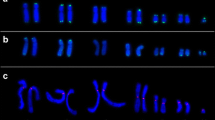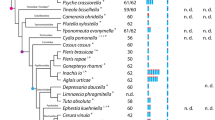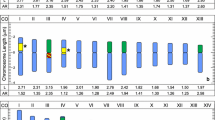Abstract
We analyse chromosome location of H3 and H4 histone gene clusters by fluorescence in-situ hybridization (FISH) in 35 species of Acrididae grasshoppers belonging to seven subfamilies. As in other organisms, H3 and H4 co-localized in the same chromosome region in the 11 species where double FISH was performed with the H3 and H4 DNA probes. Chromosome location of H3-H4 histone gene clusters showed high regularity in the species analysed, with all of them carrying a single H3-H4 cluster in an autosome which, in most cases, was located interstitially in the proximal chromosome third. In 17 out of the 21 species with 2n♂ = 23 acrocentric chromosomes, the H3-H4-carrying autosome was about eighth in order of decreasing size. Two of the four exceptions changed H3-H4 localization to proximal (Pezotettix giornae) or distal (Tropidopola graeca) in the eighth-sized autosome, but the remainder (the two Eyprepocnemis species) showed the H3-H4 cluster distally located in the second-sized autosome. All 14 species with 2n♂ = 17 chromosomes (including three long metacentric autosome pairs, five acrocentric autosome pairs and an acrocentric X chromosome) carried an interstitial H3-H4 cluster in the short arm of the smallest of the three long metacentric pairs. These results suggest that chromosome location of H3-H4 histone gene clusters seem to be highly conservative in Acrididae grasshoppers. The change in H3-H4 location from the acrocentric medium-sized autosome in the 2n♂ = 23 karyotype to the long metacentric autosome in the 2n♂ = 17 karyotype is most parsimoniously explained by common ancestry, i.e. by the involvement of the H3-H4-carrying acrocentric in the centric fusion that gave rise to the smallest of the three long metacentric autosomes of 2n♂ = 17 species.



Similar content being viewed by others
Abbreviations
- BLAST:
-
Basic Local Alignment Search Tool
- CMA3:
-
chromomycin A3
- DAPI:
-
4′,6-diamidino-2-phenylindole
- FISH:
-
fluorescence in-situ hybridization
- NCBI:
-
National Center for Biotechnology Information
- NOR:
-
nucleolus organizer region
- PCR:
-
polymerase chain reaction
- rDNA:
-
ribosomal DNA
References
Bugrov A, Novikova O, Mayorov V, Adkison L, Blinov A (2006) Molecular phylogeny of Palaearctic genera of Gomphocerinae grasshoppers (Orthoptera, Acrididae). System Entomol 31:362–368
Cabrero J, Camacho JPM (1986a) Cytogenetic studies in gomphocerine grasshoppers. 1. Comparative analysis of chromosome C-banding pattern. Heredity 56:365–372
Cabrero J, Camacho JPM (1986b) Cytogenetic studies in gomphocerine grasshoppers.2. Chromosomal location of active Nucleolar Organizing Regions. Can J Genet Cytol 28:540–544
Cabrero J, Camacho JPM (2008) Location and expression of ribosomal RNA genes in grasshoppers: abundance of silent and cryptic loci. Chromosome Res 16:595–607
Cabrero J, Bugrov A, Warchalowska-Sliwa E, López-León MD, Perfectti F, Camacho JPM (2003) Comparative FISH analysis in five species of Eyprepocnemidine grasshoppers. Heredity 90:377–381
Camacho JPM, Cabrero J (1982) Supernumerary segments in five species of grasshoppers (Orthoptera:Acridoidea). Genetica 59:113–117
Camacho JPM, Cabrero J, Viseras E, López-León MD, Navas-Castillo J, Alché JD (1991) G-Banding in two species of grasshopper and its relationship to C, N, and fluorescence banding techniques. Genome 34:638–643
Childs G, Maxson R, Cohn RH, Kedes L (1981) Orphons: dispersed genetic elements derived from tandem repetitive genes of eucaryotes. Cell 23:651–663
Colgan DJ, McLauchlan A, Wilson GDF et al (1998) Histone H3 and U2 snRNA DNA sequences and arthropod molecular evolution. Austral J Zool 46:419–437
Contreras D, Chapco W (2006) Molecular phylogenetic evidence for multiple dispersal events in gomphocerine grasshoppers. J Orthoptera Res 15:91–98
Eirín-López JM, Ruiz MF, González-Tizón AM, Martínez A, Sánchez L, Méndez J (2004) Molecular evolutionary characterization of the mussel Mytilus histone multigene family: First record of a tandemly repeated unit of five histone genes containing an H1 subtype with “orphon” features. J Mol Evol 58:131–144
Fox DP, Santos JL (1985) N-bands and nucleolus expression in Schistocerca gregaria and Locusta migratoria. Heredity 54:333–341
Graves RA, Marzluff WF, Giebelhaus DH, Schultz GA (1985) Quantitative and qualitative changes in histone gene expression during early mouse embryo development. Proc Natl Acad Sci USA 82:5685–5689
Hankeln T, Keyl HG, Ross R, Schmidt ER (1993) Evolution of histone gene loci in chironomid midges. Genome 36:852–862
Hewitt GM (1979) Grasshoppers and Crickets. Gebrüder-Borntraeger, Berlin
Kedes LH (1979) Histone genes and histone messengers. Annu Rev Biochem 48:837–870
López-León MD, Cabrero J, Camacho JPM (1999) Unusually high amount of inactive ribosomal DNA in the grasshopper Stauroderus scalaris. Chromosome Res 7:83–88
Maxson R, Cohn R, Kedes L, Mohun T (1983) Expression and organization of histone genes. Annu Rev Genet 17:239–277
Old RW, Callan GH, Gross KW (1977) Localization of histone gene transcripts in newt lampbrush chromosomes by in-situ hybridization. J Cell Sci 27:57–79
Pardue ML, Kedes LH, Weinberg ES, Birnstiel ML (1977) Localization of sequences coding for histone messenger RNA in the chromosomes of Drosophila melanogaster. Chromosoma 63:135–151
Pendás AM, Morán P, García-Vázquez E (1994) Organization and chromosomal location of the major histone cluster in brown trout, Atlantic salmon and rainbow trout. Chromosoma 103:147–152
Pineau P, Henry M, Suspène R et al (2005) A universal primer set for PCR amplification of nuclear histone H4 genes from all animal species. Mol Biol Evol 22:582–588
Ranz JM, González J, Casals F, Ruiz A (2003) Low occurrence of gene transposition events during the evolution of the genus Drosophila. Evolution 57:1325–1335
Santos JL, Arana P, Giráldez R (1983) Chromosome C-banding patterns in Spanish Acridoidea. Genetica 61:65–74
Schienman JE, Lozovskaya ER, Strausbaugh LD (1998) Drosophila virilis has atypical kinds and arrangements of histone repeats. Chromosoma 107:529–539
Tripputi P, Emanuel BS, Croce CM, Green LG, Stein GS, Stein JL (1986) Human histone genes map to multiple chromosomes. Proc Natl Acad Sci USA 83:3185–3188
Turner PC, Bagenal EBD, Vlad MT, Woodland HR (1988) The organization and expression of histone genes from Xenopus borealis. Nucl Acids Res 16:3471–3485
Ushinsky SC, Bussey H, Ahmed AA, Wang Y, Friesen J, Williams BA, Storms RK (1997) Histone H1 in Saccharomyces cerevisiae. Yeast 13:151–161
Viseras E, Camacho JPM (1985) The B-chromosome system of Omocestus bolivari. Changes in B-behaviour in M4-polysomic B-males. Heredity 54:385–390
Wells JR, Coles LS, Robins AJ (1989) Organization of histone genes and their variants. In: Hnilica LS, Stein GS, Stein JL (eds) Histones and Other Basic Proteins. CRC Press, Boca Raton, FL, pp 253–267
Zhang L, Bao Z, Wang S, Huang X, Hu J (2007) Chromosome rearrangements in Pectinidae (Bivalvia: Pteriomorphia) implied based on chromosomal localization of histone H3 gene in four scallops. Genetica 130:193–198
Acknowledgements
We thank Alexander Bugrov and Dragan Chobanov for sending us fixed materials of Eyprepocnemis unicolor and Tropidopola graeca, respectively, and Walther Traut and two anonymous referees for useful comments. We also thank Tatiana López for technical assistance and David Martínez for English corrections. This study was supported by grants from the Spanish Ministerio de Ciencia y Tecnología (CGL2006-06307) and Plan Andaluz de Investigación (CVI-1664). This research was partially financed by FEDER funds.
Author information
Authors and Affiliations
Corresponding author
Additional information
Responsible Editor: Walther Traut
Rights and permissions
About this article
Cite this article
Cabrero, J., López-León, M.D., Teruel, M. et al. Chromosome mapping of H3 and H4 histone gene clusters in 35 species of acridid grasshoppers. Chromosome Res 17, 397–404 (2009). https://doi.org/10.1007/s10577-009-9030-5
Received:
Revised:
Accepted:
Published:
Issue Date:
DOI: https://doi.org/10.1007/s10577-009-9030-5




